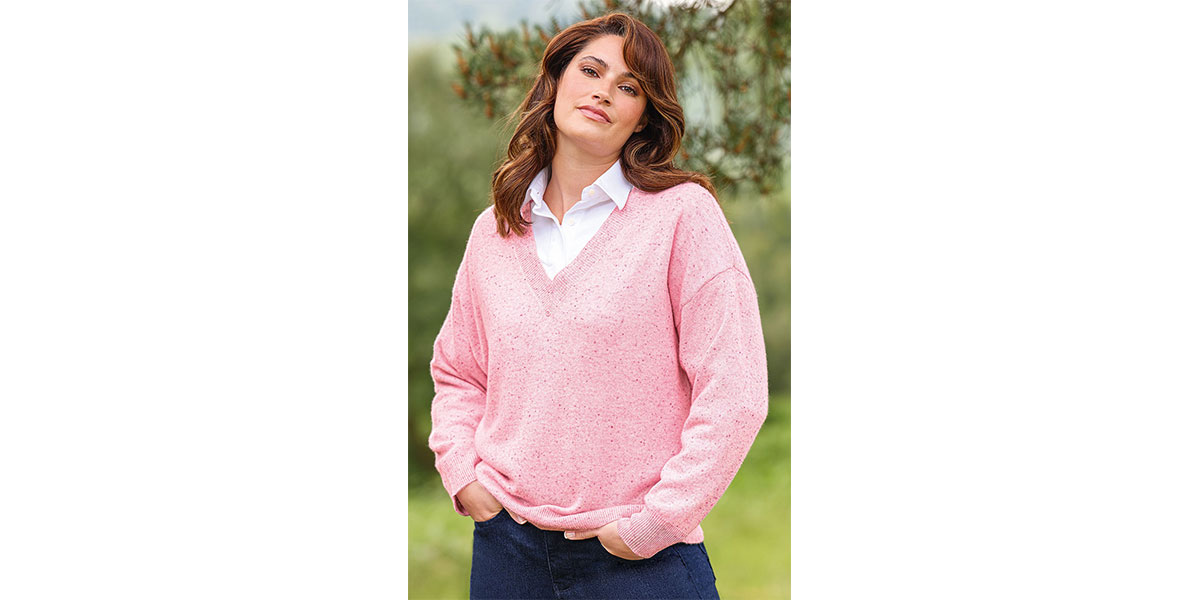Cashmere is a sought-after, soft, cosy and comforting material that makes up some of the most beautiful and luxurious garments suitable for colder weather. It’s made from goat's hair and goes through a lengthy manufacturing process before it reaches your wardrobe.
Cashmere’s luxury appeal makes it a prized material that’s often considered to be quite expensive. That’s why it’s important to keep it in the best condition to make it last as long as possible.
If you’re thinking about investing in cashmere or merely want to add to your collection, it's important to find out everything you need to know about this exquisite natural fibre. From what it is and how to properly care for it, we’ll show you how you can prolong the life of your cashmere garments so you can enjoy them for longer.
What is cashmere?
Cashmere is a natural fibre that comes from the hair of the Kashmir goat. These goats live in regions where temperatures can reach below -40 degrees, so their hair fibres are designed to help them withstand the extreme conditions, which is why cashmere garments are so good at retaining warmth.
The fibres of the goat’s undercoat need to be separated from the rougher, protective outer coat of hair. This is a lengthy and labour intensive process.
Most cashmere used to create clothing is sourced from Kashmir goats in the Gobi Desert.
However, the best quality cashmere can be found from goats living in Inner Mongolia. These goats live high up in the Himalayan mountains where the temperatures drop the most, and so they grow longer and finer-quality hair to cope with the climate.
We love Brodie Cashmere as their luxurious garments are created using the finest cashmere from Mongolia. Discover their collection of timeless ladies cashmere clothing.
When the Kashmir goats start to shed their winter coats, the hair is hand-combed from underneath the goat’s belly to be collected in very small quantities. This mainly occurs in the springtime when the hair starts to release as the goats moult.
The fibres are first dyed to the required colour, which can leave the fibres tangled and matted. Teasing the hair helps open up the fibres ready for the next step. This is when they can be blended with other colours or other fibres, such as Merino wool or silk.
After this, the cashmere is processed in a carding machine that detangles and combs the hair into rovings (thin sheets), which is a process that has remained unchanged since the 1800s.
The rovings are spun into yarn by twisting the fibres together, which helps to give the cashmere its strength. It is then woven, laying out the colour, design, and pattern of the cashmere garment, which has been decided before the weaving process starts.
The garment is then very carefully washed to help the fabric to return to its original soft feel. Cashmere is a very delicate fabric but, if it is looked after properly — i.e. if it’s treated, washed, and cared for correctly — it can be a luxurious garment that lasts a lifetime.
To make cashmere, a lot of the process must be done by hand. Collecting the fibres from goats in the Himalayas can be a tough and arduous job, and the goats themselves produce less than 200g of hair a year. In comparison, sheep can produce over three kilograms a year. Because of this, it generally takes two or more goats to make a single 2-ply sweater.
What’s more, there is now a higher demand for cashmere garments in the fashion industry, which has also caused the fabric to become increasingly valuable and expensive.
Despite feeling light and soft to the touch, cashmere is one of the warmest natural fibres. If you’re looking for an extra layer of warmth in the colder seasons which still has a luxurious finish, cashmere is the perfect choice.
Here are our favourite tips for how to find the right piece of cashmere clothing to suit you.
- 1. Choose a higher ply count for durability
Ply of yarn refers to how many ends are used within a course of knitted structure. Most commonly 2ply and 3 ply yarns are used but single ply yarns are possible. 2ply meaning 2 ends of yarn and 3ply meaning 3 ends. The higher the ply count, the stronger and less likely to develop holes your item will be. It is worth noting, however, that a higher ply doesn’t always correlate with higher quality.
The versatile nature of cashmere means that you can wear it all year round, selecting a specific ply count to suit the season. 2 ply clothing will see you through a brisk spring or summer, while 3 ply is perfect for a comforting winter knit.
- 2. Opt for a greater gauge for a more finely knitted garment
Gauge is related to the machine the fabric is knitted on, referring to the amount of needles per inch on the knitting frame. The higher the gauge count the more needles per inch resulting in a finer knitted fabric.
- 3. Go for a silk blend for a more affordable option
If you’re keen on cashmere but not on the high price, opt for a silk blend. The two luxurious fabrics blend well together and are lower in price than pure cashmere. You can shop our luxury silk and cashmere collection here.
How to style cashmere
Here are a few of our favourite ways to style cashmere:
Layered over a white shirt
 This lightweight V-neck jumper combines comfort and style, making it an essential in any everyday wardrobe. The deep V-neck is made to be layered over a crisp white shirt on breezy days, or wear it alone to enjoy true luxury.
This lightweight V-neck jumper combines comfort and style, making it an essential in any everyday wardrobe. The deep V-neck is made to be layered over a crisp white shirt on breezy days, or wear it alone to enjoy true luxury.
Due to its delicate nature, the best method of cleaning your cashmere garment is gently by hand. As tempting as it may be, even the hand-wash setting on your washing machine can be too vigorous for the fine cashmere fibres.
Spot cleaning can help to prolong the life of a garment you wear regularly, however, if you plan to store your cashmere for a prolonged period, it is best to give it a thorough clean. It may not look dirty, but any trapped particles in the fibres, such as dust, skin, or hair, can attract moths. The last thing you want is to find your favourite cardigan full of holes!
Washing your garments
- 1. To begin, find a clean bowl or sink. This must be absolutely devoid of food, dirt, or any cleaning chemicals, as this residue could damage your cashmere. We recommend having a dedicated bowl for the hand-washing of cashmere and knitwear for this reason.
- 2. Place your garment in lukewarm water with a small amount of gentle detergent. Ideally, you should use a specially-formulated cashmere shampoo for the best results and least risk. Once you add the detergent, ensure that it is fully dissolved in the water before adding your clothing. Move the garment around gently and soak for up to 30 minutes, although five minutes is often enough time.
- 3. Turn your garment inside out and squeeze gently to remove excess water. Do not wring out the garment, however, as this can stretch the delicate fibres and lead to damage and misshaping. Each garment should be washed separately to avoid any colour bleeding and to allow you to give the cashmere the attention it deserves.
- 4. Thoroughly rinse the garment in a new bowl of water at the same temperature used initially. Once again, ensure that the bowl is completely clean and free of any residue, especially anything that might have been dislodged from the garment.
Dry your cashmere gently
When drying your garment, under no circumstances tumble dry - the cashmere will shrink and become damaged. Once you have rinsed and squeezed out some of the excess water, it is recommended that you re-shape it to its original size, and dry it flat over a towel. Avoid radiators, direct heat, and sunlight. And, ideally, do not hang out to dry as this can also stretch and damage the fibres.
To iron any creases from your cashmere, press the garment under a damp cloth with the iron at the lowest possible setting.
Treated with patience and care, quality cashmere will get softer and improve with age. Giving it time to rest after wearing will also help prolong its life.
Storing your cashmere clothing
As mentioned earlier, before storing for any length of time, you should ensure your cashmere is thoroughly cleaned to avoid attracting moths and other insects. De-creasing and de-pilling before storage will also extend the lifespan and quality of your cashmere.
Garments should be stored inside out in a dust-free and well-aired cupboard, away from direct sunlight and any risk of dampness. A dedicated storage bag is highly recommended to keep your cashmere as new.
Moths and repairs
Of course, there is always the possibility that moths will haunt you regardless. We recommend using aromatic cedar blocks and hangers to fend off any potential invasion, as well as keeping your garments thoroughly clean.
If you’ve already fallen victim to the little monsters, fear not! You can take advantage of our repairs service, and our cashmere technician can invisibly repair any holes you may find. It’s also worth having a thorough clean of your storage area to ensure it doesn’t happen again - moth traps are always an option, and we’ve heard that freezing your cashmere can work too.
Pilling/bobbling of cashmere
If you notice small balls of fibres on the surface of your garment, don’t be alarmed. Knitwear can sometimes shed small fibres during initial wear, and softer fabrics such as cashmere are more prone to this than others.
They can also happen in response to friction,which can occur when another, coarser material is worn against the garment, such as wool or synthetic fibres. This is not an indication of a low-quality garment - it is merely loose fibres working their way out of the garment. They will naturally disappear during the washing process. Regular washing will minimise the appearance of these bobbles.
How to use a cashmere comb
You can also use a cashmere comb to remove bobbles if they don’t come off when you wash your item. They are specially designed to remove pills while helping to preserve the fabric.
To use a cashmere comb, first, lay your clothing on a flat surface. Gently pass the comb over the bobbles and repeat this motion, making sure to always move in the same direction, until the pills are picked up by the teeth of the comb and removed.
Start your cashmere collection today
Few fabrics rival the opulence and warmth of cashmere - it’s a practical and stylish choice that’s sure to become a steady favourite in your wardrobe, come sunny or cloudy days.
Discover our full collection of cashmere clothing here.



